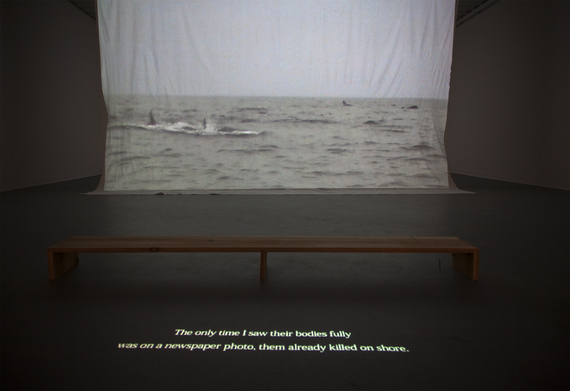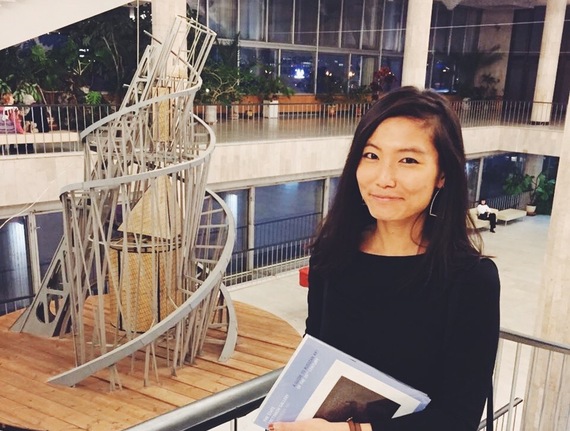Xinran Yuan, 2015. Courtesy of the artist.
Xinran Yuan is a visual artist in New York City. She has exhibited internationally in the U.S., Iceland, China, and Switzerland. Xinran has shot documentaries in Iceland, was an artist resident at Banff Research in Culture in partnership with Liverpool Biennial, and has recently been selected for a year-long residency at the Center for Book Arts, New York. She currently manages projects for the internationally-renowned artist Cai Guo-Qiang.
For the past six years, Xinran's art has focused on the ocean. Having spent a significant part of her childhood on coastal construction sites in China, where her father designed and engineered commercial ports, she developed a deep fascination with the changing coastline. In 2012, she took on a residency in a former herring town in Northern Iceland, where she worked closely with the fishing community and documented their practices today and memories of the bygone herring era.

Xinran Yuan, Seeing Landing, installation view, 2014, 2-channel video projection, muslin screening, two cedar benches. Courtesy of the artist
Xinran's approach to environmental issues ultimately returns to the issue of seeing, or according to her, "our (in)ability to see", as she proposes through an artist's lens a series of questions from "what does herring look like when it's in the ocean?" to "how do we visualize the vast network that surrounds us - ecological, environmental, sociological, and geopolitical?" Xinran's artworks span across sculpture, drawing, poetry, and video. In the stunning videos of hers, black whales jump out of the gray water, aged seamen sit in a communal hot tub reminiscing a sea from the past, bubbling like a boiling pot full of silver herring. Viewers are invited to hear the whispers and cries of the ocean along with tales told by people whose identities and livelihood depend on it.
My favorite piece by Xinran is ladder, et, an installation in which she assembled materials through a system of poetic gestures, such as untreated pine connected by handcrafted Japanese joinery yet provisionally propped up by a slender plaster pole over text silkscreened on the floor. As I crouched to read the text "[r]emember the exhilarating feeling of achievement when we climb up a ladder?" which is a quote from Yoko Ono, I thought about the issues of mentorship in the arts, a field often perceived as opaque, alternative, perhaps elitist, and all the symbolic ladders that young artists have to climb to inhale the air of achievement. So I decided to ask her how she launched her career in visual arts, and tell us about the people and experiences instrumental to her growth.
Xinran Yuan, Ladder, et, detail, 2011, pine, plaster, silkscreened text. Courtesy of the artist
Xinran formulated the following seven pieces of advice for young and aspiring artists in college:
1. Choose the right program for yourself.
Art schools offer focused trainings that benefit those who desire to spend concentrated time developing their professional tools at school. For others, the different schools of thoughts present at a liberal arts environment is crucial for forming their artistic language. Research universities often have big art departments that combine art and design. Some schools are technique-oriented, whereas others are more conceptual. My own undergraduate experience at the Department of Visual and Environmental Studies (VES) at Harvard University exposed me to the most current contemporary art theory and practice across disciplines through small group settings and mentorship from faculty who are active and accomplished in their own practice. Each year, up to ten visiting faculty - practicing artists and filmmakers - are invited to teach and lecture; brought along with them are new inquiries and perspectives that truly make the Department special. I remember visiting the Swedish artist Sophie Tottie's year-long studio on Linden Street, and while surrounded by her work in progress, experiencing an immense feeling of admiration and longing.
2. Be active gaining mentorship and apprenticeship opportunities.
While formal mentorship demands a lot of time and commitment from the mentor, most artists enjoy sharing their process and practice with an observant audience. For example, I gained my woodworking skills from a two-year "apprenticeship" that I "set up" with Walter Stanul: by all the time hanging out at the woodshop that he manages at the Carpenter Center for the Visual Arts. An accomplished guitar maker and musician, Walter taught me to understand wood with a most sensitive approach, noticing the different colors, weight, density, cellular patterns, and most importantly, sound. My "apprenticeship" with him was instrumental in shaping my aesthetics and sensibility in installations, where I often incorporate hand-planed and joined wood of different species.
3. See more. See more with your own eyes.
Visit museums on a regular basis, and when with the artworks, let go of the wall text and art history textbooks. Oftentimes when an artwork is presented to the public, it has already been labeled with what is perceived as the "correct" meaning or interpretation. For art students, it is much more important to articulate exactly what is in front of you and why it is interesting/uninteresting to you, than to be able to name and label things in art historically correct terms. Ultimately, these international conversations one has with the artworks can generate fruitful examination and understanding of one's own practice.
4. Gain an open perspective of art and life.
When I taught advanced studio courses, I often introduced my students first to Allan Kaprow's The Education of the Un-Artist from his Essays on the Blurring of Art and Life. Because I believe that a successful undergraduate education in visual art is one that prepares students to first be responsible participants in the world - in life - and then be responsible participants in the art world. A moment of special significance in my own art education was when I performed the Fluxus piece "Newspaper Music" with Alison Knowles during her residency at the Radcliffe Institute. Reflecting on the Fluxus ideology of going out of art and into life has liberated my own practice in many ways. After all, both making art and making life are lifelong pursuits.
5. Keep an open attitude by trying different roles in the art world.
Organize a talk, curate a show, write a review, visit an art fair, guide a museum tour: these are all experiences that are inseparable from being a contemporary artist. As far as I'm concerned, there is nothing harmful about working as a gallery intern for a summer as long as one can figure out the finance creatively. Schools tend to steer students away from all conversations about the commercial aspects of art, but very soon many graduates find themselves in New York juggling several jobs and not knowing how to begin selling their work. I would encourage college students to acquaint themselves with different roles in the art world, be it commercial or non-profit, auction houses or artist-run spaces. It will also help expand your notions of a career in art.
6. Engage with all kinds of techniques and technology.
Fine artists are often material and process-oriented (myself included). Yet looking around I can't help but be amazed by the visualization tools 3D animators are using to create forms and experiences. Right now I am incorporating in my practice the most ancient bookbinding and letterpress techniques while thinking a lot about virtual reality. I love the fact that we are at an era where all tools and techniques are widely available, and I do think the art world and the world at large would benefit from artists utilizing new technologies in their creative processes.
7. Find your community and be supported.
Know that a career of a professional artist is hard, and that there is no standard path or curve, and certainly no prediction when your career will "bloom." And this is not the only reason why artists should identify or establish communities that receive, support, and sustain their work. Throughout history, artists have formed collaboratives and collectives to support each other's practice and together gain better visibility. Contemporary practices, such as social practice, have opened possibilities for artists to closely engage with communities outside the art world and its audience. More and more artists are also collaborating with scientists and fields experts in their research. As competitive and ego-driven the art world may appear to be, the most sustainable careers are built through exchange.
Xinran Yuan's work can be viewed on her website: http://www.xinranyuan.com


